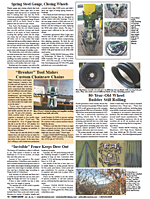Saffron Taking Root In North America
Growing the exotic spice saffron evokes images of the Middle East, not Vermont or California or Quebec. But those are areas where growers are excited about the potential of saffron as a new high-value crop. Actually, Saffron has been grown since the 1700’s in Pennsylvania in Amish communities.
Considering saffron sells for $20 to $100 per gram, its minimal growing needs and late fall harvest time, there seems to be plenty of potential. But the labor intensive hand-picking that’s required means it’s not for everyone.
The recent uptick in interest started in 2015 with a trial at the University of Vermont by Margaret Skinner and Arash Ghalehgolabbehbahani, the husband of a grad student from Iran.
“We started by growing it in high tunnels,” Skinner says.
Saffron was planted in milk crates that could be moved out of the greenhouse when tomatoes were grown through the summer. Then, after the tomato plants were removed, the crates were put back in the greenhouse. It blooms in the fall and by late October and November, the three stigmas in the flowers are reddish/orange and ready to harvest. When dried, they are the saffron spice.
“I still think there are advantages of growing them under some sort of cover - such as added heat, and no rain on the flowers to affect quality,” Skinner says. “But we were surprised that grown in the field, yields have been better than Iran. Maybe because of higher organic matter and more moisture.”
Sarah Salatino, owner of Full Circle Gardens in Essex, Vt., planted saffron in raised beds in 2017 as part of the trial.
“I have a perennial nursery and do some annuals as well on 1 1/2 acres,” Salatino says. “I got into saffron because it comes in the fall when we’re not as busy.”
She planted saffron corms in September and some of the stigmas were ready to harvest by late October 2017. She dried some of the small crop on paper towels in sunny windows and others in a warm oven for a couple of hours and has used the saffron in cookies, rice, chicken and other dishes.
“Saffron is such a subtle flavor, kind of like a floral spice,” Salatino says.
She notes that harvest is labor intensive, but the plants require little care through the summer. Her biggest challenge is rodents that chew on the tender green shoots. She placed 1/4-in. hardware cloth in the beds and uses rodent-proof covers in the spring.
As part of the North American Center for Saffron Research & Development group, she sees plenty of demand for saffron and plans to continue to grow it after she phases out of the nursery business.
Customers who buy saffron include high-end restaurant chefs and people with culinary uses for everything from maple syrup to beer. Saffron is also known for medicinal properties.
More research is necessary, Skinner says, to see where it can be grown (now recommended for Zones 5 and 6, though there’s been much success in Zone 4), and to set standards for the quality of saffron. Part of that is determining the best corms to buy. They currently range from 25 cents to $5/corm. Many growers, like Salatino, buy the largest ones, up to 4-in. diameter, from Roco Saffron in the Netherlands (www.us.rocosaffron.com/shop), which requires orders of 1,000 or more corms.
Skinner encourages gardeners interested in saffron to search local sources and start small with just 50 corms or so. The corms multiply and need to be divided after about five years.
The key thing to remember, she says, is that they are fall-bearing. Though they may appear dead during the summer, they are just dormant and will bloom in the fall.
The North American center that focuses on saffron research offers good information about growing saffron.
Contact: FARM SHOW Followup, Margaret Skinner, North American Center for Saffron Research & Development, University of Vermont, 661 Spear St., Burlington, Vt. 05405 (ph 802 656-5440; mskinner@uvm.edu; www.uvm.edu/~saffron/).

Click here to download page story appeared in.
Click here to read entire issue
Saffron Taking Root In North America CROPS Miscellaneous Growing the exotic spice saffron evokes images of the Middle East not Vermont or California or Quebec But those are areas where growers are excited about the potential of saffron as a new high-value crop Actually Saffron has been grown since the 1700’s in Pennsylvania in Amish communities Considering saffron sells for $20 to $100 per gram its minimal growing needs and late fall harvest time there seems to be plenty of potential But the labor intensive hand-picking that’s required means it’s not for everyone The recent uptick in interest started in 2015 with a trial at the University of Vermont by Margaret Skinner and Arash Ghalehgolabbehbahani the husband of a grad student from Iran “We started by growing it in high tunnels ” Skinner says Saffron was planted in milk crates that could be moved out of the greenhouse when tomatoes were grown through the summer Then after the tomato plants were removed the crates were put back in the greenhouse It blooms in the fall and by late October and November the three stigmas in the flowers are reddish/orange and ready to harvest When dried they are the saffron spice “I still think there are advantages of growing them under some sort of cover - such as added heat and no rain on the flowers to affect quality ” Skinner says “But we were surprised that grown in the field yields have been better than Iran Maybe because of higher organic matter and more moisture ” Sarah Salatino owner of Full Circle Gardens in Essex Vt planted saffron in raised beds in 2017 as part of the trial “I have a perennial nursery and do some annuals as well on 1 1/2 acres ” Salatino says “I got into saffron because it comes in the fall when we’re not as busy ” She planted saffron corms in September and some of the stigmas were ready to harvest by late October 2017 She dried some of the small crop on paper towels in sunny windows and others in a warm oven for a couple of hours and has used the saffron in cookies rice chicken and other dishes “Saffron is such a subtle flavor kind of like a floral spice ” Salatino says She notes that harvest is labor intensive but the plants require little care through the summer Her biggest challenge is rodents that chew on the tender green shoots She placed 1/4-in hardware cloth in the beds and uses rodent-proof covers in the spring As part of the North American Center for Saffron Research & Development group she sees plenty of demand for saffron and plans to continue to grow it after she phases out of the nursery business Customers who buy saffron include high-end restaurant chefs and people with culinary uses for everything from maple syrup to beer Saffron is also known for medicinal properties More research is necessary Skinner says to see where it can be grown now recommended for Zones 5 and 6 though there’s been much success in Zone 4 and to set standards for the quality of saffron Part of that is determining the best corms to buy They currently range from 25 cents to $5/corm Many growers like Salatino buy the largest ones up to 4-in diameter from Roco Saffron in the Netherlands www us rocosaffron com/shop which requires orders of 1 000 or more corms Skinner encourages gardeners interested in saffron to search local sources and start small with just 50 corms or so The corms multiply and need to be divided after about five years The key thing to remember she says is that they are fall-bearing Though they may appear dead during the summer they are just dormant and will bloom in the fall The North American center that focuses on saffron research offers good information about growing saffron Contact: FARM SHOW Followup Margaret Skinner North American Center for Saffron Research & Development University of Vermont 661 Spear St Burlington Vt 05405 ph 802 656-5440; mskinner@uvm edu; www uvm edu/~saffron/








